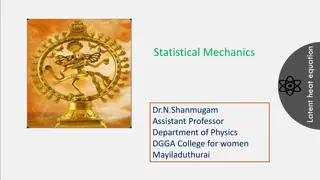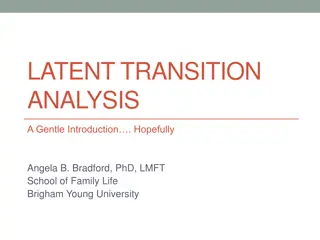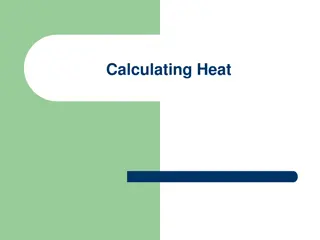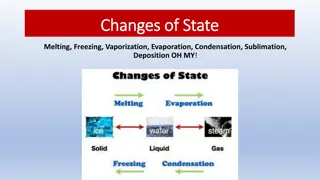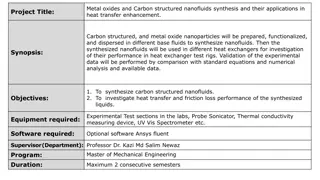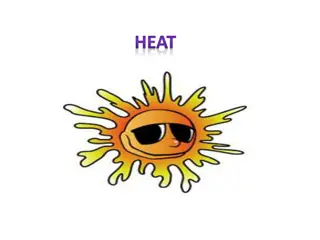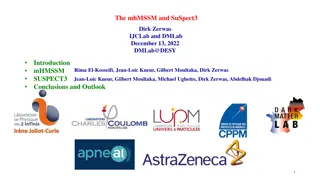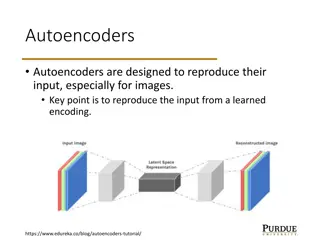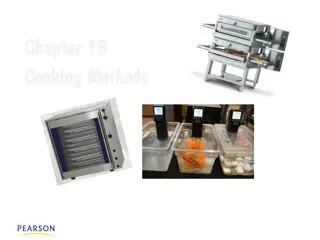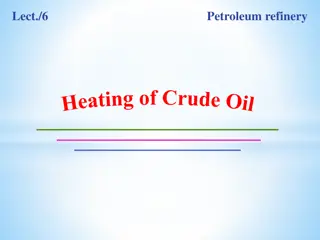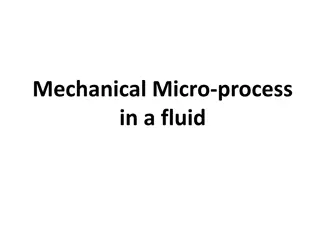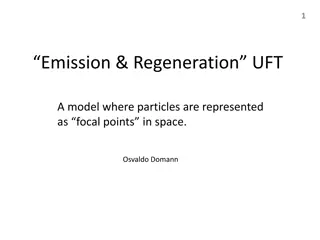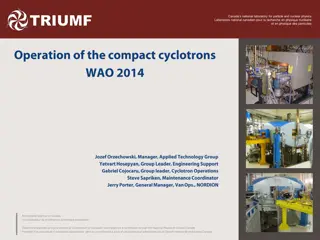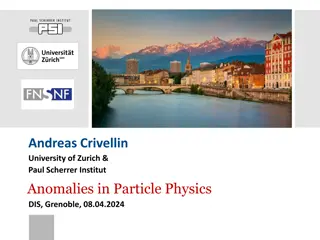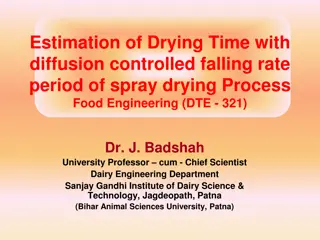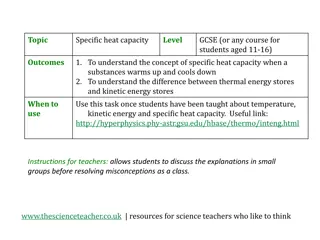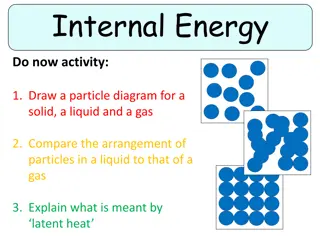Understanding Specific Latent Heat and Particle Changes
Internal energy, forces of attraction in gases vs. solids, and latent heat concepts are explained. Particles changing state are visualized through a graph. Self-assessment points and the calculation for specific latent heat of fusion are discussed. The rearrangement of the equation for specific latent heat of fusion is explored.
Download Presentation

Please find below an Image/Link to download the presentation.
The content on the website is provided AS IS for your information and personal use only. It may not be sold, licensed, or shared on other websites without obtaining consent from the author. Download presentation by click this link. If you encounter any issues during the download, it is possible that the publisher has removed the file from their server.
E N D
Presentation Transcript
Specific Latent Heat Do now activity: 1. Define the term internal energy . 2. Explain the differences in the forces of attraction found between particles of a gas compared to particles of a solid. 3. Explain what is meant by latent heat
Progress indicators GOOD PROGRESS: - Describe what is happening to the particles when a solid turns to liquid - Explain what is meant by specific latent heat of fusion OUTSTANDING PROGRESS: - To be able to use and rearrange the calculation for specific latent heat of fusion
Latent heat is the energy transferred to a substance when it changes state. It is the energy needed by the particles to break free from one another
Ice at -20oC is taken from a freezer and heated at a constant rate. The graph shows what will happen to its temperature. Describe the changes that the particles go through at each stage of the graph [6].
Self-assessment: 1) 2) Some particles are in a solid state, and some particles are in a liquid state (1). 3) All particles are in a liquid state (1). 4) Some particles are in a liquid state, and some particles are in a gaseous state (1). 5) All particles are in a gaseous state (1). Final mark at stages 2 and 4, the energy is being used to break the intermolecular bonds between the particles. (1) All particles are in a solid state (1). 200oC 5 4 100oC 3 2 0oC 1 -20oC
The specific latent heat of fusion LFof a substance is the energy needed to change the state of 1kg of the substance from a solid to a liquid, at its melting point (without changing the temperature). Units? 1 kg 1 kg Specific latent heat of fusion, LF = energy, E mass, m
Rearranging the equation: Think > Pair > Share: How would you rearrange the formula for specific latent heat of fusion LF, in order to find out the: Energy (joules, J) = Specific latent heat of fusion x mass Energy Mass (kilograms, kg) = Specific latent heat of fusion
Quick Check 1. Calculate the energy required to convert 1.5kg of ice to water. The specific latent heat of fusion of water is 334,000 J/kg. (3 marks) 2. The energy required to covert an unknown mass of ice into water was 145,000J, the specific latent heat of fusion of water is 334,000 J/kg. Calculate the mass of ice. (3 marks)
Self-assessment: 1. E = m x L E = 1.5kg x 334,000 E = 501,000 J 2. M = E / L M = 145,000J / 334,000J/kg M = 0.43 kg
The specific latent heat of vaporisation Lvof a substance is the energy needed to change the state of 1kg of a substance from liquid to vapour, at it s boiling point (i.e. without changing its temperature) 1 kg 1 kg energy, E Specific latent heat of vaporisation , Lv = mass, m
Rearranging the equation: Think > Pair > Share: How would you rearrange the formula for specific latent heat of fusion LV, in order to find out the: Energy (joules, J) = Specific latent heat of vaporisation x mass Energy Mass (kilograms, kg) = Specific latent heat of vaporisation
Quick Check a) A mass of water was weighed and found to be 0.152kg, the heater was turned on and the mass dropped to 0.144kg in the time taken to supply 18,400 J of energy to the boiling water. Use the data to calculate the specific latent heat of vaporisation of the water. (3 marks) b) A mass of water was weighed and found to be 0.6kg prior to a heater being turned on. The heater was turned on for exactly 10 minutes and after the 10 minutes the mass of water was found to be 0.465kg. Use the specific latent heat of vaporisation of water from the previous question to calculate how much energy was transferred to the water? (3 marks)
Self-assessment: a) 0.152kg - 0.144kg = 0.008kg Lv = E / m Lv = 18,000J/0.008kg = 2,300,000J/kg b) 0.6kg 0.465kg = 0.135kg E = Lv x m E = 2,300,000J/Kg x 0.135kg = 310,500J
Task: Watch this video and answer the following questions: https://www.youtube.com/watch?v=x7GZ2DXef84 1. Calculate the energy required to 0.5kg of ice to water. The specific latent heat of fusion of water is 334,000 J/kg. 2. Calculate the energy required to convert 0.15kg of ethanol from a liquid to a vapour. The specific heat of vaporisation of ethanol is 846,000 J/kg.
Self-assessment: 1. E = m x L, E = 0.5kg x 334,000 J/kg E = 167,000 J 2. E = m x L E = 0.15kg x 846,000 J/kg E = 126,900 J
Plenary WhatsApp message Write a WhatsApp message to your friend telling them what you have learnt this lesson!!
Resources Resources
water. The specific latent heat of fusion of water is water. The specific latent heat of fusion of water is water. The specific latent heat of fusion of water is ethanol from a liquid to a vapour. The specific heat ethanol from a liquid to a vapour. The specific heat ethanol from a liquid to a vapour. The specific heat Calculate the energy required to convert 0.15kg of Calculate the energy required to convert 0.15kg of Calculate the energy required to convert 0.15kg of Calculate the energy required to 0.5kg of ice to Calculate the energy required to 0.5kg of ice to Calculate the energy required to 0.5kg of ice to of vaporisation of ethanol is 846,000 J/kg of vaporisation of ethanol is 846,000 J/kg of vaporisation of ethanol is 846,000 J/kg 334,000 J/kg. 334,000 J/kg. 334,000 J/kg. 2. 2. 2. 1. 1. 1.


